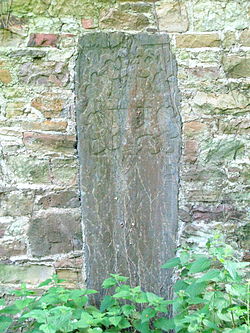Inislounaght Abbey
| Inislounaght Cistercian Abbey | |
|---|---|

|
|
| location |
County Tipperary |
| Coordinates: | 52 ° 21 '0 " N , 7 ° 43' 50" W |
| Serial number according to Janauschek |
333 |
| Patronage | St. Mary |
| founding year | 1147 |
| Year of dissolution / annulment |
1540 |
| Mother monastery | Monasteranenagh Abbey |
| Primary Abbey | Clairvaux Monastery |
|
Daughter monasteries |
Glanawydan Abbey (1170) |
Inislounaght Abbey ( Irish Inis Leamhnachta , older Mainistir na Siúire , Latin Surium; Suir) is a former Cistercian abbey in County Tipperary in what is now the Republic of Ireland . The former monastery was near Marlfield on the western edge of Clonmel around 250 m from the River Suir , at that time an important traffic artery from which the Latin name is derived.
history
The monastery was founded in 1147/1148 (according to other information not until 1151). It is disputed whether it was a daughter monastery of Mellifont Abbey or of Monasteranenagh Abbey . In any case, it belonged to the filiation of Clairvaux Primary Abbey . The monastery settled the daughter monasteries Glanawydan Abbey , Fermoy Abbey , Corcomroe Abbey . The Glangragh Abbey mentioned in this context could be identical to Glanawydan Abbey, on the other hand, a Glangragh Abbey in County Down (Northern Ireland) is mentioned repeatedly in older publications. The monastery became involved in the Mellifont conspiracy around 1220 and was therefore placed under Furness Abbey in 1227 . A monk from Furness was appointed abbot but rejected by the convent until Stephen of Lexington visited the abbey. To strengthen the discipline, 1249 monks from Furness were sent to Inislounaght.
The monastery was heavily indebted after a period of prosperity at the end of the 14th century and the church was in disrepair in 1467. Before the monastery was abolished in 1540, the abbey only had five monks. In 1542 Thomas Butler, who later became the Baron of Caher, received the monastery. In 1577 the monastery passed to Cormac M'Teige M'Carthy.
Buildings and plant
The ruins of the abbey were still visible in the 18th century. Today, however, there are no more remains. In the Protestant church of Marfield, parts have been built in, such as the east window and a Romanesque passage from shortly before 1200.
Web links
- Site of the Certosa di Firenze to the monastery
- Website of Cistercians Sheffield (English)
- Picture gallery of the Protestant church with the preserved remains of the abbey
- Description of the preserved Romanesque portal
Remarks
- ↑ cf. Archive link ( Memento of the original from December 19, 2007 in the Internet Archive ) Info: The archive link was inserted automatically and has not yet been checked. Please check the original and archive link according to the instructions and then remove this notice.
- ↑ Thomas d'Arcy M'Gee: A History of the Attempts to Establish the Protestant Reformation in Ireland ... , 2nd ed. 1853, Boston: Patrick Donahoe, p. 386; William Cobbett: History of the Protestant Reformation in England and Ireland (unpaginated), Vol. II, London: self-published 1823